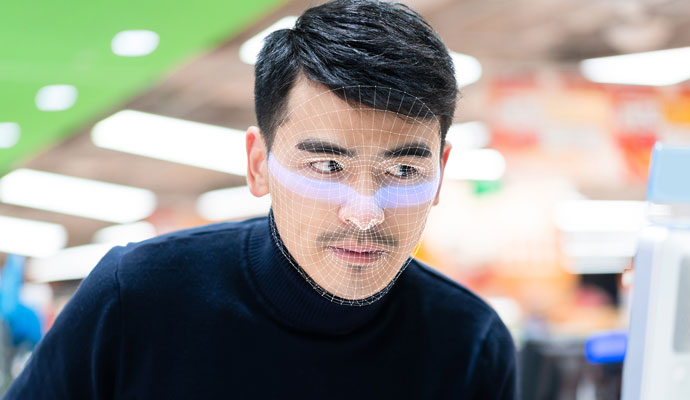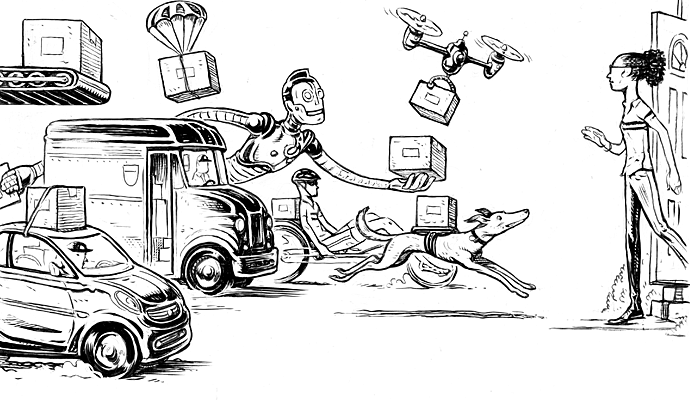Logistical feats

A version of this article appeared in the Spring 2022 issue of strategy+business.
Christopher Mims, a technology columnist at the Wall Street Journal, is one of the leading chroniclers of the increasingly intense and complex tango between humans and the software and hardware that governs their lives as professionals and consumers. In his recent book, Arriving Today: From Factory to Front Door—Why Everything Has Changed About How and What We Buy, he delves deeply into the constellation of issues raised by our long supply chains and continually optimizing logistics functions. These challenges have been thrown into sharp relief not just by the pandemic, but also by a wider understanding of the human costs of the systems that deliver efficiency and delight to consumers. In a conversation with strategy+business, Mims describes how his efforts to trace the path of an object from a factory in Asia to households in the United States raised important questions about the trading systems, managers, employees, and technology that make supply chains work, for better and for worse.
Read the original article here
Closing the agile achievement gap

A version of this article appeared in the Spring 2022 issue of strategy+business.
The nature of competitive advantage has shifted. Companies need to move beyond digital to address new dynamics in order to stand out. Find out how to build the unique capabilities that enable differentiation at PwC’s transformation page.
Here’s an agile cautionary tale: a certain US-based bank wanted to be faster on its feet, transform end-to-end customer experiences, and gain an edge over newer, nimbler fintech competitors. So, naturally, it turned to the agile playbook—the set of practices derived from software development to bring multidisciplinary teams together in order to make quick progress on short-term projects. It established daily stand-up meetings and retrospectives—the “ceremonies” of agile. It created agile teams to develop innovative new apps, build better business processes, and craft technology solutions that would support a bevy of new digital offerings. But company leaders soon realized they had a big problem on their hands.
Although the bank was using agile techniques to make some progress, it wasn’t becoming more agile as an organization. It was planting a lot of agile trees that weren’t growing into an agile forest. In technical terms, it wasn’t achieving what we call enterprise agility. When companies scale agile effectively across the enterprise, they gain the capability to adapt to everything the market throws at them. In doing so, they remain competitive and fiscally sound, no matter the scenario.
Read the original article here
Is it right or productive to watch workers?

It goes without saying that the biggest shift in the workplace over the last two years has been its disappearance. Or rather, its retreat from the physical world and its reemergence in the work-anywhere digital limbo of Zoom meetings and Slack channels. And, with a few caveats, the robust conclusion has been that, yes, remote employees can still get their work done from their kitchen table, their spare bedroom, their shed, or the patio of their favourite coffee shop.
But let’s be honest: the office isn’t merely a place to do work—it can also be the place to be observed doing work. This is why a significant number of companies whose workforce has recently gone remote have enlisted the help of surveillance software, also known as “tattleware” or “bossware,” to know what their employees are doing.
There’s an old saw in business: what gets measured gets managed. That has been elevated to gospel when it comes to raw materials, waste, energy use, emissions, and so forth. Viewed this way, surveillance tech may not be an altogether bad idea. There is value in measuring what your employees are doing and how productive they are. What makes surveillance challenging is connecting it to management, or even control.
In January 2021, reports emerged that one in five companies were using surveillance software to remotely monitor their employees—in some cases without the employees’ knowledge or consent.
Read the original article here
The “My Way” Highway: Disruption in last-mile logistics

Andrew Grove’s quote is nearly a quarter century old, but it could have been written today. The COVID-19 pandemic was one of those strategic inflection points for e-commerce supply chains. Fundamental changes occurred in supplier offerings and consumer preferences during this challenging time. Such structural changes cannot be addressed by continuing to do what we did before, but trying to do it better, faster and cheaper. Instead, they shift the boundaries that decisions are based on, and make new things not only possible but necessary. Whether these changes are a threat or an opportunity depends on the actions taken by supply chain leaders and challengers.
We have identified five trends that are driving the e-commerce supply chain inflection point.
- (Accelerating) rise of e-commerce
- Rise of the retailer logistician
- Rise of same-day/next-day delivery
- Rise of the data scientist
- Rise of robotics, automation and autonomy
They’re not new: Most companies doing e-business were already grappling with them before the spring of 2020. But the trends accelerated the change; what might normally have taken five years to unfold, happened in five months during the pandemic.
When new trends in the market are small, they can be ignored. When those trends move from niche to mainstream, ignoring them becomes a death sentence.
While the five trends mentioned above don’t necessarily signal the end of traditional supply chain networks, and they do have an effect on all aspects of supply chain management, our analysis speaks directly to the growth of e-commerce supply chains. Let’s look at each in more detail.
Read the original article from SCMR
State of flux

Where there’s change, there are new possibilities — and opportunities to take action, transform, and move forward. But in a new normal, in which circumstances change by the day, the possibilities of tomorrow can be hard to spot. Learn more about reconfiguring for a remade world: Hello, tomorrow.
The energy transition is fully underway. Indeed, the forces of policy, investment, and technological change have put into place a set of dynamics not seen in the energy sector since the Industrial Revolution. Spurred by innovation, capital, and regulation, business models are evolving rapidly, forging new equations for creating value. As companies and investors place decarbonization at the center of their strategy, societal and consumer pressures are compelling new forms of collaboration. More than 190 countries have committed to the goals of the 2015 Paris Agreement, and the recent net-zero pronouncements by China and the Biden administration have transformed governments from cheerleaders to directors of the transition. From South Korea to Europe, massive economic stimulus packages are aimed at building more resilient and sustainable economies and energy systems.
Read the original article here
What if the hybrid office isn't real?

I’m sitting with three other people in a meeting room — warm wood-effect walls, scooped white leather chairs around an oval-shaped white table — next to a bank of floor-to-ceiling windows. We’re high up, although I couldn’t say what floor; the windows face a coastal city, all high-rises and sunny skies, beaches in the distance and turquoise blue water. Looking down at the cars and streets far, far below, I’m momentarily swayed by vertigo and decide that it would be better if I backed away.
Which I do with a click of the trigger on the handset connected to my Oculus Quest 2 virtual reality (VR) headset, my avatar landing in a safer spot on the other side of the table.
I am, obviously, not actually in an office high-rise somewhere sunny. My physical person is alone, sitting in my kitchen, in my house, in not-so-sunny Surrey, England. This meeting room, from the dust motes glinting in the sunlight to the vertigo-inducing view, is generated entirely in VR, the work of the virtual events and meetings platform Mesmerise.
Read the original article here
How the need for secure supply chains is propelling blockchain

When several large automakers considered how to confront a looming sustainability problem, they turned to blockchain. The issue? Even as electric vehicles (EVs) penetrate the market in growing numbers, with global sales jumping 40 percent year-on-year in 2019 according to the IEA, questions around the ethical sourcing and disposal of their batteries have lingered.
In response, Volvo and BMW are using blockchain technology to track the raw materials used in EV lithium-based batteries from the source. This includes the mining of the key component, cobalt, which has historically been marred by child labor and other human rights abuses. Mercedes is working on a pilot blockchain project to track CO2 emissions in the cobalt supply chain, as part of its efforts to create a carbon-neutral passenger car fleet by 2039.
It is this ability to provide provenance — to track and trace materials, products, and services — that has been singled out by PwC as the biggest driver behind the widespread adoption of blockchain technology. In a 2020 study, PwC’s economists ranked the top five uses of blockchain by their economic potential, predicting that using blockchain to prove provenance could generate US$962 billion for global GDP over the next decade. Notably, this was more than double the potential of any other use case.
In many ways, this focus on provenance is a sign of the times.
Read the original article here
The cyborg behind the sales counter

The 2015 opening of the Henn-na Hotel in Nagasaki, Japan, was staffed almost entirely by 243 robots, hailed as a milestone in bringing artificial intelligence (AI) to customer service. What a disappointment, then, when a few years later, the hotel laid off more than half of those robot workers and hired humans in part because customers found the robots annoying, unreliable, and off-putting. It’s a result that the authors of a new study on human enhancement technology (HET) might have predicted.
Even before COVID forced businesses to think about how to serve customers in a safe, contact-free way, firms were turning to AI to streamline and enhance service. There are increasingly humanlike robots who sell coffee, wait tables, and work as hotel bellhops at trial locations around the world. But more frequently, rather than going full robot, employees are equipped with HET devices. It’s not unusual for doctors to wear smart glasses that stream patient data during appointments, for example, or for car rental service representatives to don headsets for faster communication with AI virtual agents or bots about vehicle availability. Similarly, research is underway on how bionic lenses could aid logistics workers, and how wearable monitors could provide real-time feedback about employees’ changing stress levels or underlying health conditions. There are even emotion-detecting devices in the works that could sense prospective customers’ moods.
Read the original article here
Creating an agile mind-set at PepsiCo

A version of this article appeared in the Spring 2020 issue of strategy+business.
It appeared to be a routine day at the cookie factory in Mar del Plata, Argentina — a facility operated by PepsiCo Central and South America (CASA). Freshly baked treats were continually transferred from an enormous industrial oven onto an assembly line for cooling. As machines whirred and workers moved about, a piece of the conveyor belt broke down, bringing the action to an abrupt stop. The turn of events was no surprise to anyone on the line. They thought they knew what would happen next: The line operator would have to order another $300 part from Italy, and production wouldn’t resume until it arrived.
The operator on the line that day in 2018 happened to be a skilled tinkerer who owned a 3D printer. He knew there must be a faster and less expensive way to get the part. That evening, at home, he began applying his problem-solving skills. It took him several tries and some 13 prototypes, but in the end, he created a replacement part that could be manufactured locally and quickly and for just $2. The line operator is now a go-to source for other employees in the company seeking to start similar initiatives.
This innovation didn’t happen by chance. In previous years, it would probably not have happened at all. But in 2018, PepsiCo CASA started an initiative to instill what we call an “agile mind-set” among employees.
Read the original article here
The rise of the last-mile exchange

Park yourself at a typical residential intersection in the U.S., and you’ll watch a parade of delivery vehicles pass by over the course of the day. Trucks from FedEx, UPS, and the U.S. Postal Service (USPS) crisscross neighborhoods, retrieving and delivering packages, sometimes more than once. Increasingly, they are joined by trucks from regional shippers such as OnTrac or LaserShip, as well as by unmarked vehicles with non-uniformed drivers, who drop off packages for companies including Walmart and online startups such as Roadie, Doorman, and Sidecar. Soon, fleets of vans bearing Amazon’s logo, operated by independent companies, will be joining the mix.
The rising pace of activity along what’s called the last mile of the retail sales chain reflects the boom in e-commerce. According to the U.S. Census Bureau, e-commerce accounts for about 9 per cent of total retail sales and is growing at a double-digit clip. The number of packages delivered annually in the U.S. is expected to rise from 11 billion in 2018 to 16 billion by 2020, according to estimates from Strategy&, PwC’s strategy consulting business. B2C deliveries, generated mainly by e-commerce, account for more than half of today’s volume and will make up two-thirds of volume by 2020.
In many ways, this seems like a sunny story all around. Consumers have more shopping choices than they have ever had, and their online purchases are delivered faster than seemed possible just a few years ago.
Read the original article here